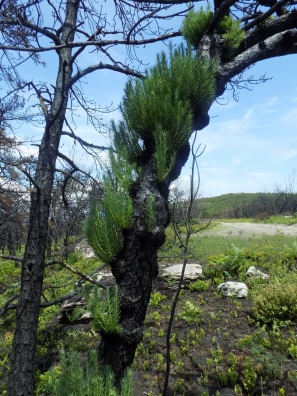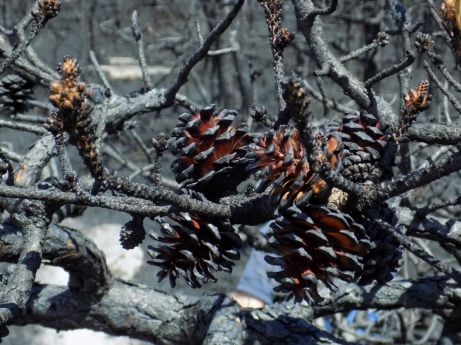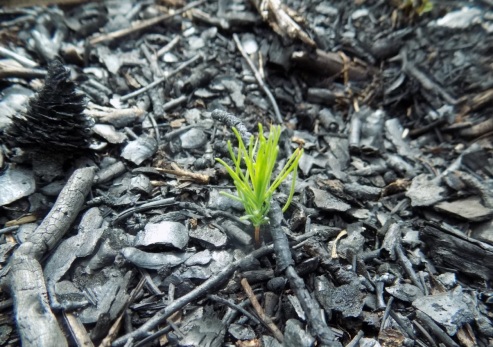Text and photos by Lindsey Feinberg, Student Conservation Association Intern at Sam’s Point Please ask permission to use photos.
Located within Minnewaska State Park Preserve is Sam’s Point, an area of unique ecological significance encompassing roughly 5,000 acres in the Shawangunk Mountains of southern New York. Toward the end of April, during a particularly dry and windy week, a fire broke out along the Verkeerderkill Falls Trail and engulfed over 2,000 acres of pitch pine and oak woodlands. While this may seem like a devastating event, one of the factors that make the globally rare dwarf pine ridge ecological community of Sam’s Point so unique is that it is a fire dependent ecosystem.
Since progressing into the deep summer months, Sam’s Point has experienced an explosion of new growth. Toward the end of the fire there was an extended period of cold rainy weather that continued for a week after the fire was out. Soon afterward , bracken fern (Pteridium aquilinum) fiddleheads began springing forth through the burned earth and painted trilliums (Trillium undulatum) flowered near the Ice Caves trail in an area of low intensity burn. A number of pink lady slippers (Cypripedium acaule) also popped up along the Loop Road and the Verkeerderkill Falls Trail.
Sam’s Point was fully closed until Memorial Day Weekend, when it was reopened to limited capacity with only the Loop Road and Ice Caves Trail available to the public. Park staff members were positioned at the Verkeerderkill Falls Trail with a table of educational materials in order to encourage park patrons to obey the closures and help them understand the importance of staying out of affected areas. The main concern is the potential for rapid spread of non-native invasive plant species by seeds hitchhiking in the boots and backpacks of visitors. Without competition from established plants and with the increased availability of nutrients that follows fire, invasive species have the potential to quickly establish.
Fortunately, the closures seem to be working and few invasive plants and many native species have been seen in those areas. Blueberries (Vaccinium spp.) and huckleberries (Gaylussacia baccata) have been quick to return, along with chokeberries (Photinia melanocarpa), serviceberry (Amelanchier sp.), wild raisin (Viburnum nudum) and sheep laurel (Kalmia angustifolia), which have repopulated the understory in a carpet of vibrant green. Rhodora (Rhododendron canadense), a small, showy rhododendron that is threatened in New York State, has been proliferating in high numbers in some of the wetter areas of Sam’s Point. Even bunchberry (Cornus canadensis), a wildflower more typical of cool, moist woodlands and uncommon in southern New York, is coming back near the Indian Rock Trail.
Many of the pitch pine trees that were blackened and scorched, all of which looked ostensibly dead, have exhibited new growth occurring at the base, epicormically (along the trunk), and from the top of the tree. Walking along the loop road, hints of long bristly shoots resembling bright green porcupines are apparent on a number of blackened trees. The majority of pitch pine stumps that were cut for fire control purposes have also begun re-sprouting.

Equally important for the ecology and continuance of the globally rare dwarf pine ridge community is the successful germination of pine seeds. As pitch pines get older, they lose their ability to re-sprout. Many older pitch pines will experience a wave of mortality even after new shoots appear. Possible reasons for this subsequent mortality of pitch pines is that a burned tree tends to be more stressed, and may not as resilient to any new factors that can further increase stress, such as insect predation and extreme weather events. Additionally, new shoots probably won’t distribute evenly on each tree, and this added weight on a weakened tree can cause branches to break or the entire tree to topple over. But there is still hope. The closed, charred pine cones opened soon after the fire ended, their russet innards contrasting brightly against the blackened landscape. The seeds were dispersed and fell to the ground. In order to germinate, pitch pine seeds need to be exposed to mineral soil. This is usually achieved when a fire burns through the upper duff (dead leaves and other plant material) and organic soil layers, which are more likely to burn when the fire is allowed to continue for long enough and reach a hot enough temperature. Until recently, the park staff at Sam’s Point had been unable to find any seedlings despite nearly half of the acreage on Sam’s Point being burned.

But how do you monitor 2000 acres for seedlings? You don’t. Instead, you look at a sample. One of the first post-fire initiatives by Parks’ Sam’s Point research staff was to establish 20 randomly placed research plots in order to document forest regeneration and the recovery of this natural area over time. Returning to the plots and recording information on the plants and soil helps us to understand and learn more about this ecosystem. In addition, we established photopoints in four of the research plots. Since May 7th, we have been photographing four plots from the same location on a biweekly basis. Photopoints are a great supplement to research documenting change over time, as it provides a way to visually understand what changes are taking place.
Sampling is scheduled to begin sometime in August, but one of the most exciting aspects of establishing randomly placed plots is discovering unique areas that might otherwise go unnoticed. During our fieldwork we found several areas of pitch pines averaging only 4 feet tall. Upon further examination, we discovered that the soil was extremely shallow in those spots, as little as 2 inches over solid bedrock. In July, none of Sam’s Point staff had seen any new seedlings during their regular duties around the park, but after checking in on the sections with low soil depth we were able to find a good number of seedlings. And soon after, seedlings were found in some of the wetland pockets as well. All good news for the recovery.

Sam’s Point has a number of unique, highly acidic wetlands too. While the larger pockets were relatively untouched by the fire, the smaller outflows were more vulnerable, especially in areas of extremely shallow soil. However, the wet areas that were burned along High Point Carriage Road and some other narrow strips of wetland have begun exhibiting their wetland qualities once again. Sphagnum moss, a characteristic moss genus found in bogs, has returned in some of these areas, while tiny sundews (Drosera spp.) can be seen on both the newly grown moss and the saturated but still blackened soil.
Animal activity was apparent almost immediately. The prairie warblers’ ascending trill could be heard throughout the spring in all areas of the preserve. Insect and pollinator activity has been high, especially with the return and subsequent blooms of milkweeds and meadowsweet. Park staff also noticed a number of ruffed grouse, which like forest openings. The remains of chewed up pine cones littering the forest floor are evidence of red squirrels. Eastern towhee activity was also high in the period immediately after the fire. Towhees are a species of bird that feed on pitch pine seeds as they are released from their cones. Amphibians could be spotted burrowing into the moist ground in order to keep cool.
During a fire and the initial period afterward, it is easy to focus on the destruction and negative impacts. However, it’s important to remember that fire is a vital ecological process in many environments, especially for the health and longevity of pine barren communities. The Sam’s Point Fire offers great opportunities for discovery. Researchers from the Shawangunk Ridge Biodiversity Partnership, Mohonk Preserve, The Nature Conservancy and nearby colleges like SUNY New Paltz met to discuss research needs and interests to inform management and increase our knowledge about this exceptional place and ecosystem. It’s exciting to see what the future holds for Sam’s Point.












One thought on “Rebirth After Fire”